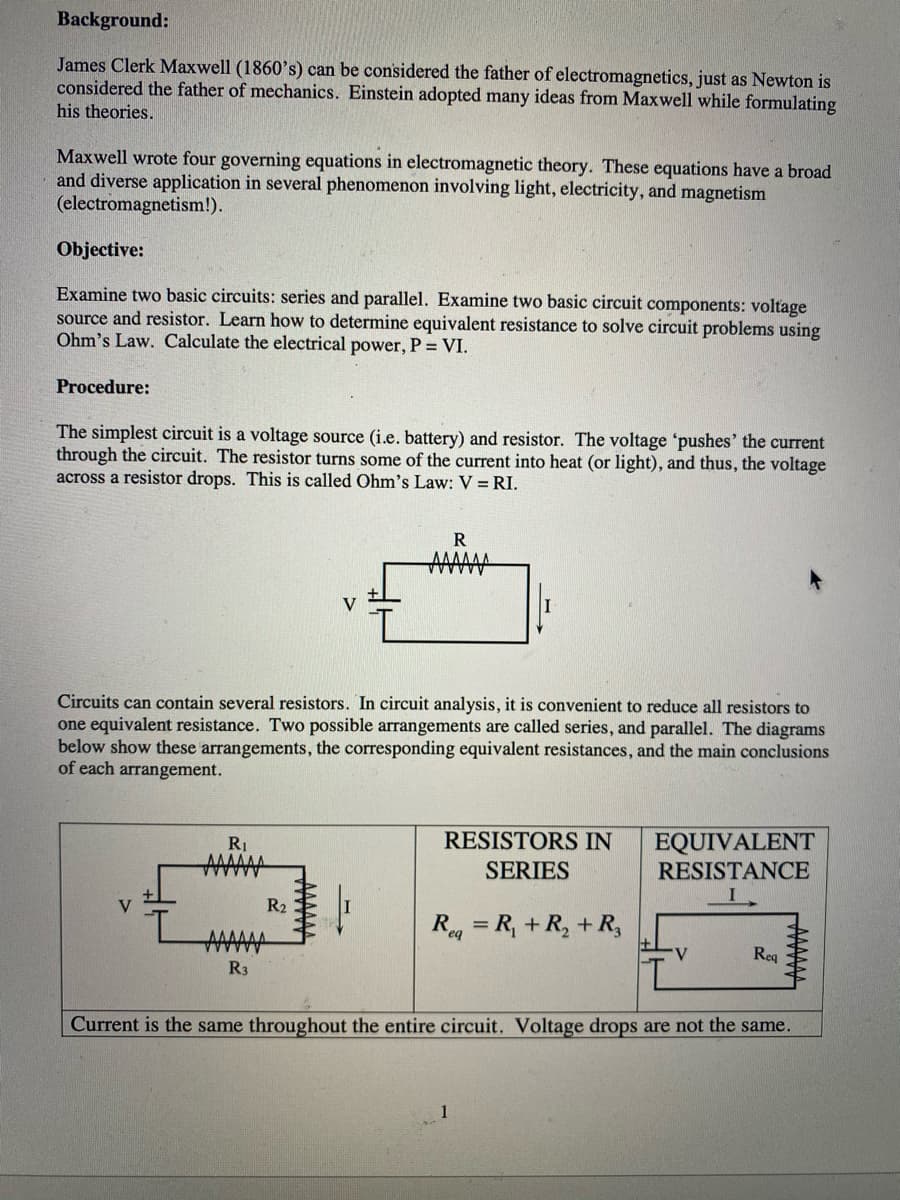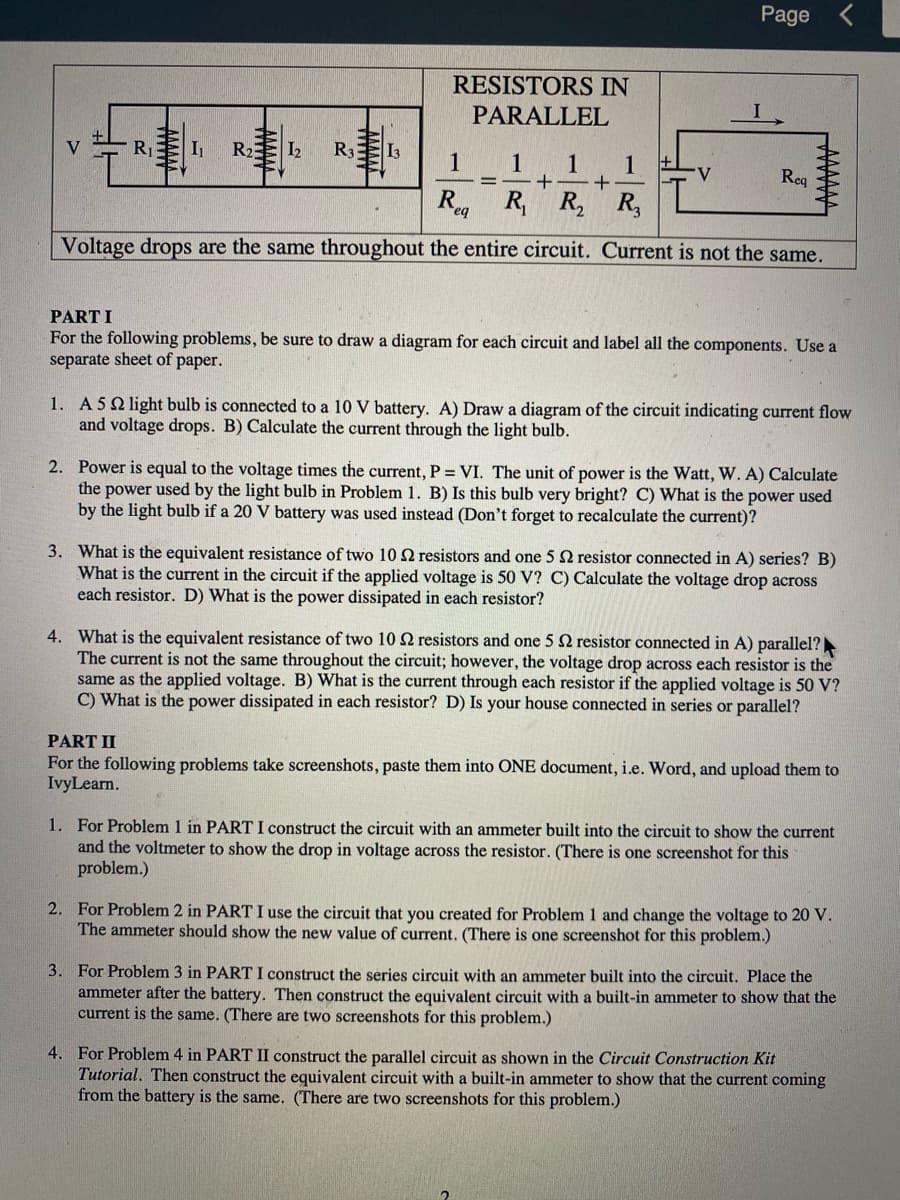4. What is the equivalent resistance of two 10 2 resistors and one 5 2 resistor connected in A) parallel? The current is not the same throughout the circuit; however, the voltage drop across each resistor is the same as the applied voltage. B) What is the current through each resistor if the applied voltage is 50 V? C) What is the power dissipated in each resistor? D) Is your house connected in series or parallel?
4. What is the equivalent resistance of two 10 2 resistors and one 5 2 resistor connected in A) parallel? The current is not the same throughout the circuit; however, the voltage drop across each resistor is the same as the applied voltage. B) What is the current through each resistor if the applied voltage is 50 V? C) What is the power dissipated in each resistor? D) Is your house connected in series or parallel?
Chapter7: Electricity
Section: Chapter Questions
Problem 6C
Related questions
Question
Question help Part 1 # 4

Transcribed Image Text:Background:
James Clerk Maxwell (1860's) can be considered the father of electromagnetics, just as Newton is
considered the father of mechanics. Einstein adopted many ideas from Maxwell while formulating
his theories.
Maxwell wrote four governing equations in electromagnetic theory. These equations have a broad
and diverse application in several phenomenon involving light, electricity, and magnetism
(electromagnetism!).
Objective:
Examine two basic circuits: series and parallel. Examine two basic circuit components: voltage
source and resistor. Learn how to determine equivalent resistance to solve circuit problems using
Ohm's Law. Calculate the electrical power, P = VI.
Procedure:
The simplest circuit is a voltage source (i.e. battery) and resistor. The voltage 'pushes' the current
through the circuit. The resistor turns some of the current into heat (or light), and thus, the voltage
across a resistor drops. This is called Ohm's Law: V = RI.
R
V
Circuits can contain several resistors. In circuit analysis, it is convenient to reduce all resistors to
one equivalent resistance. Two possible arrangements are called series, and parallel. The diagrams
below show these arrangements, the corresponding equivalent resistances, and the main conclusions
of each arrangement.
RESISTORS IN
EQUIVALENT
RESISTANCE
R1
SERIES
V
R2
AAA
Reg = R, + R, + R,
V
Req
R3
Current is the same throughout the entire circuit. Voltage drops are not the same.

Transcribed Image Text:Page
RESISTORS IN
PARALLEL
V
I
R2
I2
R3
I3
1
1
1
1
V
Req
%D
R R, R,
R,
eq
Voltage drops are the same throughout the entire circuit. Current is not the same.
PART I
For the following problems, be sure to draw a diagram for each circuit and label all the components. Use a
separate sheet of paper.
1. A5Q light bulb is connected to a 10 V battery. A) Draw a diagram of the circuit indicating current flow
and voltage drops. B) Calculate the current through the light bulb.
2. Power is equal to the voltage times the current, P = VI. The unit of power is the Watt, W. A) Calculate
the power used by the light bulb in Problem 1. B) Is this bulb very bright? C) What is the power used
by the light bulb if a 20 V battery was used instead (Don't forget to recalculate the current)?
3. What is the equivalent resistance of two 10 2 resistors and one 5 resistor connected in A) series? B)
What is the current in the circuit if the applied voltage is 50 V? C) Calculate the voltage drop across
each resistor. D) What is the power dissipated in each resistor?
4. What is the equivalent resistance of two 10 2 resistors and one 5 2 resistor connected in A) parallel?
The current is not the same throughout the circuit; however, the voltage drop across each resistor is the
same as the applied voltage. B) What is the current through each resistor if the applied voltage is 50 V?
C) What is the power dissipated in each resistor? D) Is your house connected in series or parallel?
PART II
For the following problems take screenshots, paste them into ONE document, i.e. Word, and upload them to
IvyLearn.
1. For Problem 1 in PART I construct the circuit with an ammeter built into the circuit to show the current
and the voltmeter to show the drop in voltage across the resistor. (There is one screenshot for this
problem.)
2. For Problem 2 in PART I use the circuit that you created for Problem 1 and change the voltage to 20 V.
The ammeter should show the new value of current. (There is one screenshot for this problem.)
3. For Problem 3 in PART I construct the series circuit with an ammeter built into the circuit. Place the
ammeter after the battery. Then construct the equivalent circuit with a built-in ammeter to show that the
current is the same. (There are two screenshots for this problem.)
4. For Problem 4 in PART II construct the parallel circuit as shown in the Circuit Construction Kit
Tutorial. Then construct the equivalent circuit with a built-in ammeter to show that the current coming
from the battery is the same. (There are two screenshots for this problem.)
WWW
Expert Solution
This question has been solved!
Explore an expertly crafted, step-by-step solution for a thorough understanding of key concepts.
Step by step
Solved in 4 steps

Knowledge Booster
Learn more about
Need a deep-dive on the concept behind this application? Look no further. Learn more about this topic, physics and related others by exploring similar questions and additional content below.Recommended textbooks for you


Physics for Scientists and Engineers: Foundations…
Physics
ISBN:
9781133939146
Author:
Katz, Debora M.
Publisher:
Cengage Learning


Physics for Scientists and Engineers: Foundations…
Physics
ISBN:
9781133939146
Author:
Katz, Debora M.
Publisher:
Cengage Learning